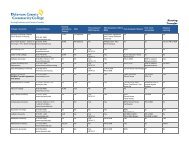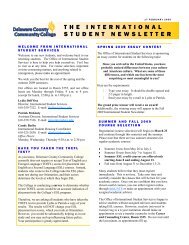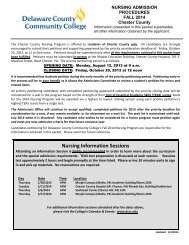2010 Catalog - Delaware County Community College
2010 Catalog - Delaware County Community College
2010 Catalog - Delaware County Community College
Create successful ePaper yourself
Turn your PDF publications into a flip-book with our unique Google optimized e-Paper software.
COURSE DESCRIPTIONS 109<br />
EMER 110<br />
Emergency Planning<br />
This course will introduce the student to the concepts<br />
of Emergency and Crisis Planning. The course provides an<br />
overview of the entire concept of planning as an activity<br />
to anticipate, prevent, prepare for, respond to and recover<br />
from any incident. Through a dynamic process, the course<br />
will break down the planning process into understandable<br />
parts such as hazard analysis, resource assessment,<br />
plan development, coordination with others, and plan<br />
implementation training and education. In addition, the<br />
student will work in an interactive program to establish a<br />
planning process for their company or municipality. The<br />
student will learn from the experiences and circumstances<br />
of others while sharpening their understanding and<br />
skills relative to the dimensions of Emergency Planning<br />
and Management.<br />
Upon successful completion of this course, students<br />
should be able to:<br />
• Define the terms and regulatory framework of<br />
emergency planning.<br />
• Identify the roles and responsibilities associated with the<br />
planning process.<br />
• Differentiate between "Emergency Planning" and<br />
"Emergency Management".<br />
• Recognize the need for Emergency Planning and the role<br />
of various functionaries in the process.<br />
• Define the terms "teamwork" and "cooperation" in<br />
emergency planning.<br />
• Identify the pitfalls of a poor or ineffective emergency<br />
planning system.<br />
• Recognize the need for, and the use of, emergency<br />
planning.<br />
• Describe how emergency planning affects emergency<br />
preparedness, response and recovery.<br />
3 Credits 2 Weekly Lecture Hours<br />
2 Weekly Laboratory Hours<br />
EMER 120<br />
Leadership and Influence<br />
This course will provide the student with an overview of<br />
the theories and concepts of leadership development. The<br />
course will examine leadership from a value (core values)<br />
approach, systems (chain of command) approach, a functional<br />
approach and a skills approach (motivation, supervision,<br />
and communications). In addition, the student will<br />
study the process approach by looking at leadership as a<br />
process of influencing an organization/group to achieve goals.<br />
Upon successful completion of this course, students<br />
should be able to:<br />
• Define the terms "leadership" and "influence" relative to<br />
emergency response.<br />
• Identify the roles and responsibilities associated<br />
with leadership.<br />
• Differentiate between leadership and ego.<br />
• Identify the need for, and the role of, leadership in the<br />
incident management system.<br />
• Define the team’s ‘teamwork’ and ‘cooperation’ relative to<br />
leadership and influence in emergency response.<br />
• Identify the consequences of poor or ineffective<br />
leadership in an emergency.<br />
• Recognize what it takes to be influential and the need for<br />
influence in certain circumstances.<br />
• Describe how leadership can influence people, their<br />
response to activities, their safety and their future<br />
leadership styles.<br />
3 Credits 2 Weekly Lecture Hours<br />
1 Weekly Laboratory Hours<br />
EMER 130<br />
Search and Rescue<br />
This course will provide the student with the knowledge<br />
concerning the general responsibilities, skills, abilities and<br />
the equipment needed by those involved in search and<br />
rescue efforts. The course also provides the student with<br />
practical exercises and search missions where they are<br />
required to utilize the proper equipment. The contents of<br />
the course include topics in three major areas: survival,<br />
support, and search and rescue. Additionally, the student<br />
is provided with an excellent opportunity to discuss and<br />
investigate the role of search and rescue in relation to<br />
incident management as well as the roles and responsibilities<br />
of search and rescue leaders. Students will learn<br />
from the experiences of others to sharpen their understanding<br />
and skills relative to search and rescue.<br />
Upon successful completion of this course, students<br />
should be able to:<br />
• Define the components of search and rescue operations<br />
and resources.<br />
• List the major responsibilities for search and rescue.<br />
• Describe the components of Incident Command System<br />
(ICS) and their functions.<br />
• Differentiate between at least three types of maps used in<br />
search and rescue.<br />
• Identify the use of topographical maps.<br />
• Define the plotting methods or grid systems.<br />
• Describe the parts of the compass.<br />
• Utilize a compass.<br />
• Define the six crucial steps in search and<br />
rescue management.<br />
• Differentiate between the two basic categories of search<br />
tactics (Passive and Active).<br />
• Describe the primary types of active search tactics.<br />
• Describe the techniques and methods used by searchers.<br />
• List searching or tactical skills needed by field searchers.<br />
• Explain why knowledge of lost person behavior can be<br />
an advantage to the searcher.<br />
3 Credits 2 Weekly Lecture Hours<br />
2 Weekly Laboratory Hours<br />
EMER 140<br />
Emergency Management<br />
Seminar<br />
This course will provide the student with a forum for<br />
discussion of the basic need for emergency management,<br />
emergency planning and incident management. This<br />
course will also overview the roles and responsibilities of<br />
the Incident Safety Officer in preparation for a series of<br />
response drills to implement student knowledge in these<br />
areas. In addition, a functional exercise will be conducted<br />
to test the course outcomes and competencies.<br />
Upon successful completion of this course, students<br />
should be able to:<br />
• Understand the application of the various roles and<br />
responsibilities in incident management.<br />
• Identify the roles and responsibilities associated with<br />
incident management.<br />
• Identify the difference between Incident Command and<br />
Unified Command.<br />
• Define the roles of various functionaries in the incident<br />
management system.<br />
• Define the terms "teamwork" and "cooperation" in<br />
incident management.<br />
• Evaluate hazards and risks associated with emergency<br />
response operations.<br />
• Correct hazardous conditions associated with emergency<br />
response operations.<br />
• Identify and correct unsafe acts that are observed during<br />
functional exercises as they apply to recognized<br />
standards provided by fire, police, medical and<br />
hazardous material regulations.<br />
• Develop a plan of action to reduce or alleviate hazards.<br />
• Implement a plan of action to reduce or alleviate hazards.<br />
1 Credit 1 Weekly Lecture Hours<br />
(EMS) Emergency Med Services<br />
EMS 100<br />
Emergency Medical<br />
Technician<br />
This intensive program is designed to instruct the prehospital<br />
care provider in the skills necessary to reduce<br />
mortality and morbidity from accident and illness. Topics<br />
covered include patient assessment, cardiopulmonary<br />
resuscitation, mechanical aids to ventilation, trauma<br />
management, head, neck and spinal injuries, fractures,<br />
medical and environmental emergencies, crisis<br />
intervention and vehicle rescue.<br />
Upon successful completion of this course, students<br />
should be able to:<br />
• Control hazards present to self, victim and bystanders at<br />
the scene of a pre-hospital medical emergency situation.<br />
• Assess extent of injury to victims suffering pre-hospital<br />
accident or illness.<br />
• Recognize and provide appropriate emergency care to<br />
victims suffering cardiac arrest and/or airway obstruction.<br />
• Assess and provide adequate emergency care to victims<br />
suffering trauma to one or more body systems<br />
• Communicate patient care information in an effective<br />
professional manner both verbally and in writing.<br />
• Assess cardiac, respiratory, diabetic and associated<br />
medical and environmental emergencies.<br />
• Evaluate obstetrical emergencies and provide appropriate<br />
assistance and/or emergency intervention to the<br />
expectant female.<br />
Prerequisite: MAT 040-Basic Mathematics and REA 050 –<br />
Reading II<br />
7 Credits 5 Weekly Lecture Hours<br />
4 Weekly Laboratory Hours<br />
EMS 110<br />
Patient Assessment<br />
This course is designed to provide the student with<br />
theory, concepts and the applications necessary to measure<br />
the pre-hospital scene and its surroundings, which will<br />
provide valuable information to the paramedic. Additionally,<br />
the student will be able to prioritize care based on patient<br />
assessment, which includes body substance isolation,<br />
scene safety, recognition and stabilization of lifethreatening<br />
conditions, identification of patients who require<br />
rapid stabilization and transportation for definitive care.<br />
Upon successful completion of this course, students<br />
should be able to:<br />
• Identify the components of patient assessment<br />
and examination.<br />
• Identify life-threatening conditions.<br />
• Outline effective patient communication techniques.<br />
• Apply interventions as identified during patient<br />
assessment.<br />
• Identify priorities of management of the medical and<br />
traumatic patient.<br />
• Effectively provide current and on-going patient care.<br />
• Recognize changes in assessment and apply appropriate<br />
interventions as indicated.<br />
3 Credits 2 Weekly Lecture Hours<br />
2 Weekly Laboratory Hours<br />
EMS 120<br />
Airway Management and<br />
Ventilation<br />
This course is designed to provide the student with<br />
theory and concepts of the anatomy and physiology of the<br />
respiratory system. The course will examine the mechanics<br />
of respiration, gases, regulation of respiration, foreign body<br />
airway obstructions and airway evaluation. In addition, the<br />
student will study the essential parameters of airway<br />
evaluation, airway management, and airway procedures.<br />
Upon successful completion of this course, students<br />
should be able to:<br />
• Discuss the assessment and management of the<br />
respiratory system.<br />
• Identify the anatomy and physiology of the<br />
respiratory system.<br />
• Describe variations in assessment and management of<br />
the respiratory system.<br />
• Outline the mechanics of the respiratory system.<br />
• Describe the regulation of the respiratory system.<br />
• Describe devices and techniques in the management of<br />
the respiratory patient.<br />
• Describe conditions and complications associated with<br />
the respiratory system.

















